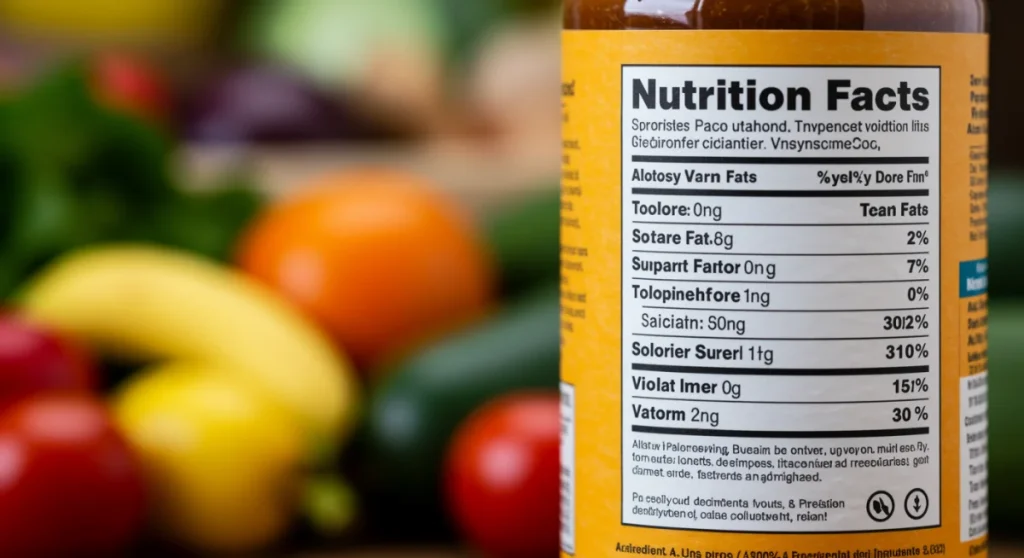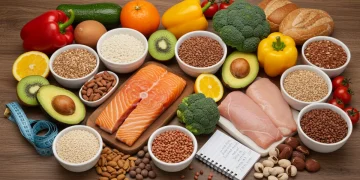2025 Guide: Decoding Food Labels & New USDA Regulations

The 2025 USDA food labeling regulations introduce significant changes aimed at enhancing consumer understanding and promoting healthier food choices, necessitating a fresh approach to decoding what’s on your plate.
Navigating the grocery store aisles can often feel like deciphering a complex code, especially when it comes to understanding what’s truly in our food. With the arrival of decoding food labels under the new 2025 USDA regulations, consumers are presented with both challenges and unprecedented opportunities to make more informed dietary choices. These updates aim to enhance transparency, simplify complex nutritional information, and empower you to better understand the impact of your food on your health.
Understanding the Shift: Why New Regulations?
The landscape of food consumption and public health is constantly evolving. As scientific understanding advances and dietary patterns shift, the need for clear, accurate, and easy-to-understand food labeling becomes paramount. The 2025 USDA regulations represent a significant step towards addressing these needs, driven by a growing demand for transparency and a concerted effort to combat diet-related health issues.
For years, consumers have expressed confusion over existing labels, often finding them difficult to interpret quickly and accurately during a busy shopping trip. This new suite of regulations seeks to bridge that gap, making it simpler for everyone, regardless of their nutritional expertise, to grasp the essential information about what they’re eating. The goal is to foster a healthier population by enabling better food choices through clearer communication.
The Driving Forces Behind the Changes
- Public Health Concerns: Rising rates of obesity, diabetes, and heart disease directly linked to dietary habits necessitate clearer guidance.
- Consumer Demand: A strong public desire for more transparency regarding ingredients, nutritional content, and sourcing.
- Scientific Advancements: New research on nutrients, allergens, and dietary impacts provides a basis for updated labeling requirements.
- Technological Capabilities: Modern printing and data management allow for more detailed and dynamic label information.
Ultimately, these regulations are not just about adding more details to a package; they are about fundamentally changing how we interact with our food. They are designed to empower individuals, giving them the tools to make choices that align with their personal health goals and values, fostering a more informed and health-conscious society.
Key Updates to Nutrition Facts Panels
Perhaps the most noticeable changes brought by the 2025 USDA regulations will be found on the Nutrition Facts panel itself. This critical section of food labels is undergoing a significant overhaul to make vital information more prominent and accessible. The aim is to highlight nutrients that are often over-consumed or under-consumed by the American public, thereby guiding healthier purchasing decisions.
One of the most anticipated changes is the revised emphasis on ‘added sugars’. Previously, consumers often struggled to differentiate between naturally occurring sugars and those intentionally added during processing. The new label will clearly distinguish between these, making it easier to identify products high in added sugars, which are often linked to adverse health outcomes. This clarity will be invaluable for individuals monitoring their sugar intake.

Enhanced Visibility and New Requirements
- Bolded Calories and Serving Sizes: Calories and serving sizes will be more prominently displayed, making them easier to spot at a glance.
- Dual Column Labeling: For certain packages that contain more than one serving but could reasonably be consumed in a single sitting, a dual column will show nutrition information per serving and per package.
- Updated Daily Values: Daily values for certain nutrients, like sodium, dietary fiber, and vitamin D, have been updated based on current scientific recommendations.
- Required Vitamin D and Potassium: Vitamin D and potassium will now be mandatory on the label, replacing Vitamins A and C, which are less commonly deficient in the American diet.
These adjustments reflect a deeper understanding of public health needs and dietary trends. By bringing certain nutrients to the forefront and providing more context around serving sizes, the USDA hopes to foster a more intuitive and effective way for consumers to manage their intake of key nutrients. The updated panel is a powerful tool for those committed to a healthier lifestyle, offering a clearer roadmap to nutritional balance.
Decoding Ingredient Lists: What’s New?
Beyond the Nutrition Facts panel, the 2025 USDA regulations also bring important modifications to the ingredient list. This section, often overlooked or skimmed, is crucial for understanding the true composition of a food product, especially for individuals with allergies, sensitivities, or specific dietary preferences. The new rules aim to make this list more transparent and user-friendly.
One notable change involves the grouping of similar ingredients. For example, all sugar-based ingredients might be listed together, even if they have different names (e.g., cane sugar, corn syrup, high-fructose corn syrup). This aggregated approach helps consumers quickly gauge the total amount of sweeteners in a product, preventing brands from disguising high sugar content by using multiple types of sugar.
Clarity in Allergen and Additive Declarations
The regulations also emphasize clearer allergen declarations. While major allergens already require prominent listing, the new rules might standardize the format or placement to ensure they are impossible to miss. This is a critical safety measure for millions of Americans with food allergies, providing peace of mind and reducing the risk of accidental exposure.
- Standardized Allergen Statements: Expect more consistent phrasing and placement for allergen warnings, making them easier to identify across different products.
- Improved Additive Descriptions: Some additives may require more specific descriptors rather than generic terms, providing greater insight into their purpose and origin.
- Source Transparency: For certain ingredients, there might be a greater emphasis on declaring their source, especially for animal products or highly processed components.
The updated ingredient list is a testament to the USDA’s commitment to consumer safety and informed choice. By making this section more coherent and comprehensive, individuals can more easily identify ingredients they wish to avoid or seek out, whether for health, ethical, or personal reasons. This enhanced transparency transforms the ingredient list from a mere legal requirement into a powerful consumer tool.
Practical Solutions for Healthier Choices
With these new regulations in place, consumers have an unprecedented opportunity to take control of their dietary health. The redesigned labels are not just for compliance; they are powerful tools that, when understood, can significantly impact your daily food choices. Adopting practical strategies for interpreting these labels will be key to maximizing their benefits.
Start by focusing on the most relevant information for your personal health goals. If you’re managing blood sugar, ‘added sugars’ will be a primary concern. If you’re watching your blood pressure, sodium content will take precedence. The new labels are designed to make these specific details jump out, so train your eye to seek them first.

Strategies for Navigating New Labels
- Prioritize Key Nutrients: Identify the nutrients most important to your health (e.g., added sugars, sodium, fiber, saturated fat) and scan for these first.
- Understand Serving Sizes: Pay close attention to the updated serving sizes and how they relate to the amount you actually consume. The dual column labeling for larger packages will be particularly helpful here.
- Compare Products: Use the clearer labels to compare similar products side-by-side, making it easier to choose the healthier option based on your criteria.
- Scrutinize Ingredient Lists: For those with allergies or specific dietary needs, thoroughly review the ingredient list, paying attention to the new grouping and allergen declarations.
Empowering yourself with knowledge about these new label formats is a proactive step towards a healthier lifestyle. These practical solutions turn the potentially overwhelming task of food shopping into an informed and efficient process, enabling you to consistently make choices that support your well-being. The goal is to move beyond simply reading the label to actively understanding and utilizing its information.
Impact on Food Manufacturers and Retailers
The ripple effect of the 2025 USDA food labeling regulations extends far beyond the consumer. Food manufacturers and retailers face significant adjustments to their production processes, packaging designs, and marketing strategies. This transition requires substantial investment and strategic planning to ensure compliance and maintain consumer trust.
For manufacturers, the changes necessitate a thorough review and potential reformulation of products to meet new nutritional criteria or to present existing information in the new format. This could involve everything from adjusting ingredient ratios to redesigning entire packaging lines. The requirement for clearer ‘added sugars’ information, for instance, might push companies to reduce sugar content in many popular items.
Challenges and Opportunities for the Industry
- Redesigning Packaging: Companies must update all product packaging to reflect the new label formats, which is a costly and time-consuming endeavor.
- Product Reformulation: Some manufacturers may choose to reformulate products to present a more favorable nutritional profile under the new, more transparent labeling guidelines.
- Supply Chain Adjustments: Greater transparency requirements may lead to changes in sourcing ingredients, especially for those with specific origin declarations.
- Consumer Education: Retailers and manufacturers will play a role in educating consumers about the new labels, helping them understand the changes and benefits.
While the initial investment and effort are considerable, these regulations also present an opportunity for brands to build greater trust with consumers. Companies that embrace transparency and proactively adapt to the new standards can differentiate themselves in the market. The ultimate impact will likely be a shift towards healthier product offerings as brands compete to meet the demands of a more informed consumer base.
Beyond the Label: A Holistic View of Food
While the 2025 USDA regulations significantly improve our ability to make informed choices at the point of purchase, it’s essential to remember that food labels are just one piece of a larger puzzle. A truly holistic view of food wellness extends beyond the package to encompass where our food comes from, how it’s produced, and its overall impact on our health and the environment.
These regulations are a powerful tool, but they should be used in conjunction with other healthy eating principles. Understanding the broader context of nutrition, including the importance of whole foods, balanced diets, and sustainable practices, will amplify the benefits derived from clearer labels. The label tells you what’s in a processed item, but your knowledge of nutrition guides you towards less processed options.
Integrating Labels into a Healthy Lifestyle
- Prioritize Whole Foods: Focus on fresh fruits, vegetables, lean proteins, and whole grains, which often don’t require labels or have very simple ones.
- Cook at Home More Often: Preparing meals from scratch gives you complete control over ingredients and nutritional content, reducing reliance on packaged foods.
- Educate Yourself: Continuously learn about nutrition, food science, and sustainable eating practices to complement label reading skills.
- Consult Professionals: For personalized dietary advice, consider speaking with a registered dietitian or nutritionist.
Ultimately, the new USDA regulations serve as an excellent catalyst for greater food literacy. They encourage us to not only read what’s on the package but also to think critically about our food sources and their journey to our plates. By combining label knowledge with a comprehensive understanding of nutrition, we can cultivate a truly healthy and sustainable relationship with food.
| Key Update | Impact for Consumers |
|---|---|
| Added Sugars Line | Easier to identify and limit consumption of added sugars in products. |
| Bolded Calories & Serving Sizes | Quickly see calorie count and realistic serving information for better portion control. |
| Updated Daily Values | Reflects current scientific recommendations, helping meet nutrient goals more accurately. |
| Clearer Allergen Declarations | Enhanced safety and peace of mind for individuals with food allergies. |
Frequently Asked Questions About 2025 Food Labels
The primary goal is to empower consumers with clearer, more accessible nutritional information, making it easier to make informed decisions that support public health and address prevalent diet-related issues like obesity and diabetes.
The new labels will clearly distinguish between naturally occurring sugars and those added during processing. This separate line item for ‘added sugars’ will help consumers identify products with high amounts of discretionary sweeteners more easily.
For packages that contain 2-3 servings but might be consumed in one sitting, dual column labeling will show nutrition facts per serving and per package. This helps consumers understand the total nutritional impact if they eat the whole container.
While major allergens already required declaration, the new regulations aim for more standardized and prominent allergen statements. This enhances safety and ensures critical allergy information is consistently clear and easy to locate on packaging.
Focus on key nutrients relevant to your health goals, pay close attention to serving sizes, and use the clearer information to compare products. Combine label reading with prioritizing whole foods and cooking more at home for optimal health benefits.
Conclusion
The 2025 USDA regulations for food labeling mark a pivotal moment in consumer empowerment and public health. By providing clearer, more intuitive nutritional information, these updates equip us with better tools to understand what we’re eating and how it impacts our bodies. While the transition will require adjustments from both consumers and industry, the long-term benefits of enhanced transparency and informed decision-making are substantial. Embracing these new labels is not just about compliance; it’s about fostering a more health-conscious society where every individual can navigate their dietary choices with confidence and clarity, ultimately leading to improved well-being for all.





